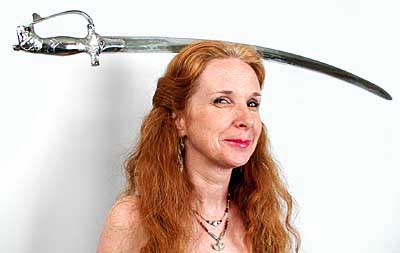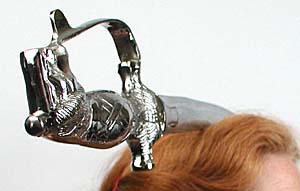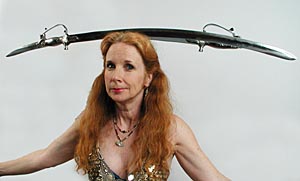Choosing and Dancing with a Belly Dance Sword
Zarifa, edited by W. Snowman
Balancing a belly dance sword is a beautiful addition to your dancing routine, but more importantly it is an exercise in one of the most important skills in belly dancing, isolation. A skilled belly dancer can restrict dancing movements to one part of her body while keeping others perfectly motionless, or moving in a different direction. Dancing with a sword is an excellent exercise to perfect this skill.

How do I dance with a sword balanced on my head? Perfect isolation can take many hours of training and can be quite daunting with a heavy sword - and painful when dropped! You may want to practice with something lighter at first - a book, block of wood, or broom handle. Remember isolation is the key.
Begin with simple shimmies: shimmy the hips while keeping your upper body and your head perfectly still. Then practice shoulder shimmies while keeping your neck and head motionless. Once you can perform shimmies without dropping your "practice sword," move on to movements requiring more control to keep your head stationary, such as camel or body waves. The downward figure eight and elevations (lift up on your toes then flat foot) while doing shimmies are not only challenging but look great while keeping a sword balanced on your head.
Once you can perform a few moves without dropping your book or broom handle (most of the time!) you can try dancing with a real sword. Most belly dancing swords have a fairly heavy handle so that the balance point is a closer to the handle. Move it around until you find the spot where it can sway a little without sliding off your head. A good balanced sword should lay on the edge with the blade perpendicular and the handle up straight and ready, easy to reach when you need it.
Some dancers find it much easier to perform sword work while wearing a turban or other head wear. This is not really "cheating" unless you use a really thick head wear or alter it to hold the sword. Some dancers have thick hair, making it easier to pick up belly dance sword work, some need a little "help."
Once you feel comfortable with isolated movements, it's time to try spins with the sword on your head. The trick is to use a dance move that puts your arms over your head so that one arm rests against the sword while you begin the spin. As the sword begins to spin with you as one, you may be able to release the sword and hold it in a perfect spin with your head and drop your arms. (Or maybe not!) You will need to move your arms back up and brace the sword as you come out of the spin so that it doesn't keep spinning and fly off your head. Don't be discouraged if this doesn't come to you easily, very few dancers can perform this move gracefully and only after years of diligent practice. When you become comfortable with controlling the sword as you move, you can begin keeping your arms further and further from actually touching the sword as you turn. A dancer experienced in sword work can make several complex changes without ever touching the sword.

How do I choose my belly dancing sword? Choose a curved blade sword or scimitar with a smooth blade and without an edge; the edge should be flat. Avoid swords with large "handguards" on the handle, such as fencing-style swords with handguards off to the side, as these will throw the balance off. Many misunderstand "balanced" to mean that the sword should balance in the middle of the blade. The balance of a belly dance sword refers to how straight it stands on edge and can be seen by the angle of the blade to the floor when balanced on its center of gravity.
Because the handle is heavier than the blade, the center of lengthwise balance of a belly dance sword usually closer to the handle than the middle of the blade. When balanced on your head, a well balanced sword should lay on the inner curved edge with the blade perfectly perpendicular to the floor. The blade should not be leaning toward the front or back. Sometimes a sword that is out of balance and leans to the front or back can be re-balanced by twisting the handle.
Do not use a battle sword for belly dancing. They are not balanced correctly and having an edge will be extremely difficult to dance with. Some swords are heavier than others and it will take some conditioning to get used to the weight. Dance until your scalp goes numb, then practice other moves!

Can I dance with more than one sword? Believe it or not, an experienced dancer can balance two swords on her head, or one on the head and another on the hip. Another fun routine is to move into a back bend with the swords touching the floor, or one on the head with the other on the stomach while doing floor work. Some even wear a blindfold while dancing with the swords on a basket balanced on their head. All of these moves require practice with a teacher who can help you.
Safety first! There are several things that can go wrong while practicing belly dance sword work, so please be careful. Although belly dancing swords don't have a point or an edge, they are still heavy and can cause serious damage or injury. Make sure your handle is solidly attached and not coming loose; swinging the sword around fast can cause the blade to come loose and fly out. Be sure to give yourself plenty of room when practicing. Belly dancing with a sword in close quarters or areas with breakables can be costly.
Other Articles
© 2004-2021 Zarifa's Touch of Egypt, all rights reserved
- Shop Zarifa's |
- Belly Dance Costume & Accessories |
- Egyptian Decor |
- Workshops & Classes |
- Belly Dance Classes
- Affiliate Program |
- Check Out |
- Contact |
- Links |
- Business Policies |
- Home
Zarifa's Touch of Egypt · Boise, Idaho 83646 · Contact